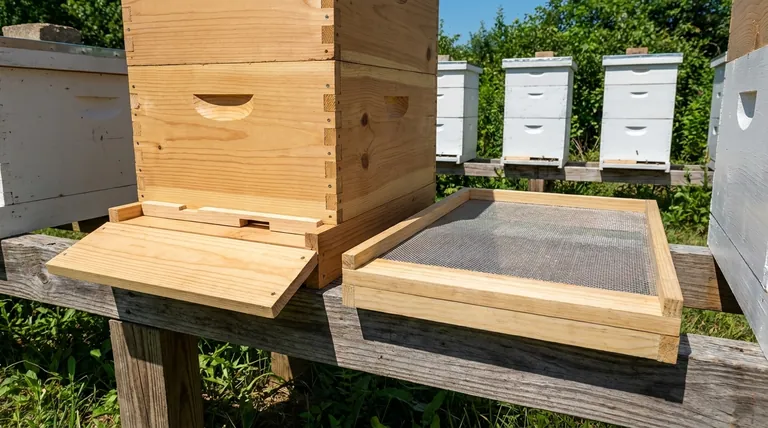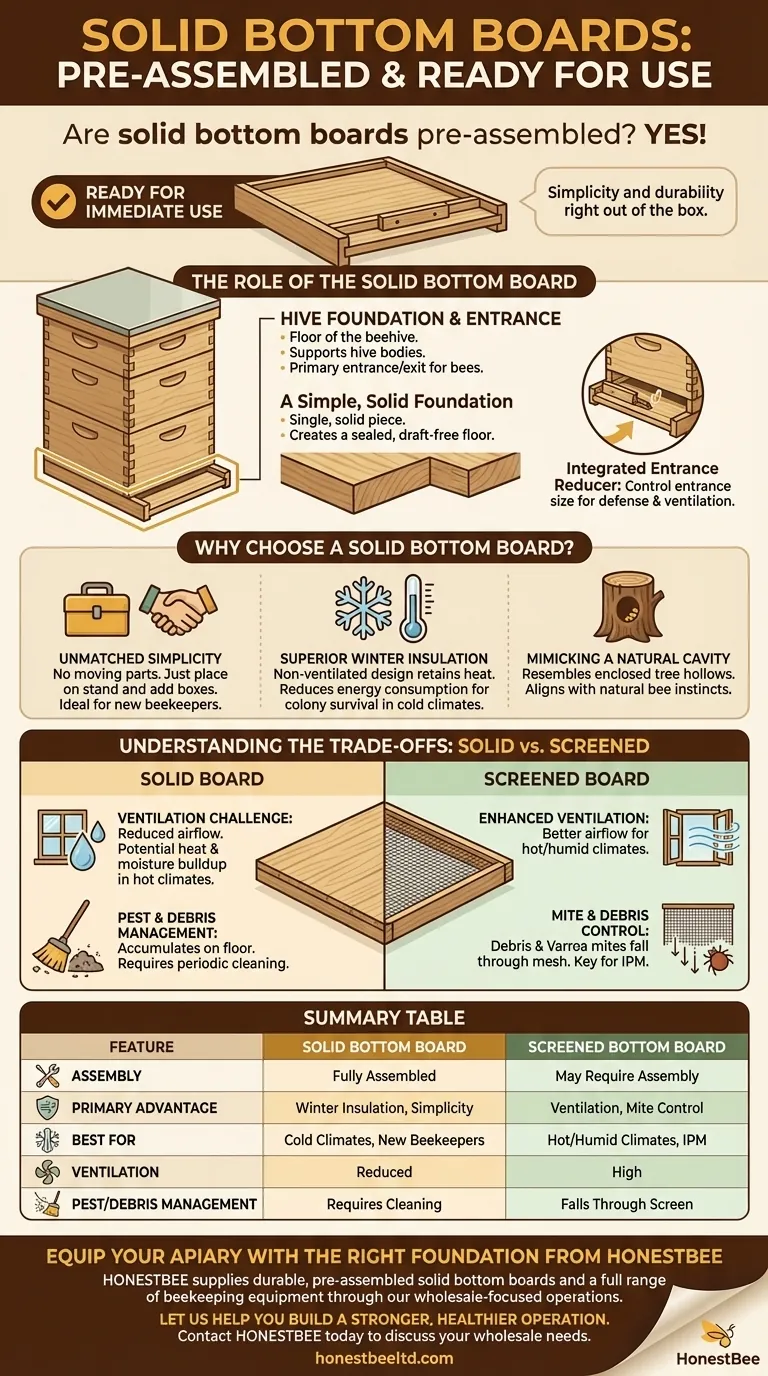Yes, solid bottom boards are sold fully assembled and are ready for immediate use. This is a key feature of their design, making them a straightforward and popular choice for beekeepers who value simplicity and durability right out of the box.
The choice of a bottom board goes beyond simple assembly. While a solid bottom board offers simplicity and excellent insulation, it's a decision that directly impacts your hive's ventilation and your strategy for managing pests like Varroa mites.

The Role of the Solid Bottom Board
A bottom board is the floor of your beehive. It provides the foundation upon which the hive bodies are stacked and serves as the primary entrance and exit for the honey bees.
A Simple, Solid Foundation
The solid bottom board is exactly what its name implies: a single, solid piece of wood. It creates a sealed, draft-free floor for the colony, which has been the traditional design for centuries.
The Integrated Entrance Reducer
Most solid bottom boards come with a small, removable wooden cleat called an entrance reducer. This piece allows you to control the size of the hive entrance, which is a critical management task. A smaller entrance helps a new or weak colony defend itself from pests and robber bees, while a larger entrance provides better ventilation during hot weather.
Why Choose a Solid Bottom Board?
Opting for a solid bottom board is often a deliberate choice based on climate, beekeeping philosophy, and desired ease of use.
Unmatched Simplicity
There are no moving parts or separate pieces to install. You simply place the solid bottom board on your hive stand, and you are ready to add your hive boxes. This simplicity is highly valued, especially by new beekeepers.
Superior Winter Insulation
The solid, non-ventilated design is a major advantage in colder climates. It helps the colony retain the heat they generate, reducing the amount of energy (and honey) they must consume to survive the winter.
Mimicking a Natural Cavity
A solid floor more closely resembles the enclosed tree cavities that honey bees naturally inhabit. Some beekeepers prefer this design, believing it aligns better with the bees' instincts.
Understanding the Trade-offs
The primary alternative to a solid bottom board is a screened bottom board. Understanding the differences is essential for making an informed decision.
The Ventilation Challenge
The main drawback of a solid bottom board is reduced ventilation. In hot and humid climates, this can lead to excess moisture and heat buildup inside the hive, potentially stressing the colony. Bees will be forced to expend energy fanning to regulate the internal temperature.
Pest and Debris Management
A screened bottom board features a wire mesh floor that allows debris and, most importantly, Varroa mites to fall out of the hive. This is a key component of an Integrated Pest Management (IPM) strategy. With a solid board, mites and debris accumulate on the floor and must be periodically cleaned out by the beekeeper.
Making the Right Choice for Your Hive
Your choice should be guided by your local climate and your priorities as a beekeeper.
- If your primary focus is simplicity and overwintering in a cold climate: The solid bottom board is an excellent, reliable choice due to its superior insulation and ease of use.
- If your primary focus is Varroa mite management and ventilation in a hot climate: A screened bottom board may be a more effective tool for maintaining colony health.
- If you want a balanced approach: Some beekeepers use solid boards during the cold winter months and switch to screened boards during the warm summer.
Ultimately, understanding how each component affects the hive environment empowers you to make the best decision for your bees.
Summary Table:
| Feature | Solid Bottom Board | Screened Bottom Board |
|---|---|---|
| Assembly | Fully assembled, ready to use | May require assembly |
| Primary Advantage | Superior winter insulation, simplicity | Enhanced ventilation, Varroa mite control |
| Best For | Cold climates, new beekeepers, simplicity | Hot/humid climates, Integrated Pest Management (IPM) |
| Ventilation | Reduced | High |
| Pest/Debris Management | Requires periodic cleaning by beekeeper | Debris and mites fall through screen |
Equip Your Apiary with the Right Foundation from HONESTBEE
Choosing the correct bottom board is a critical decision for hive health and productivity. Whether you manage a few hives or supply equipment to a large commercial apiary, having the right tools is essential.
HONESTBEE supplies durable, pre-assembled solid bottom boards and a full range of beekeeping equipment through our wholesale-focused operations. We provide the reliable, high-quality foundations that commercial apiaries and beekeeping equipment distributors need to succeed.
Let us help you build a stronger, healthier operation.
Contact HONESTBEE today to discuss your wholesale needs and get the right equipment for your climate and beekeeping goals.
Visual Guide

Related Products
- Langstroth Screen Bottom Board for Beekeeping Wholesale
- Australian Pine Wood Langstroth Screen Bottom Board for Wholesale
- HONESTBEE Wooden Bee Escape Board with Triangle Mesh Design for Beekeeping
- HONESTBEE Professional Frame Wiring Board and Jig
- Boardman Entrance Bee Feeder Durable Galvanized Steel and Wood Construction for Beekeeping
People Also Ask
- What are some considerations when choosing between solid and screened bottom boards? Optimize Hive Health & Pest Control
- What are the benefits of a screened bottom board? Boost Hive Health & Control Varroa Mites
- What are the assembly options for the Cypress Screened Bottom Board? Ready-to-Use for Immediate Hive Health
- What are the main benefits of using a Screened Bottom Board in beekeeping? Enhance Hive Health & Productivity
- What is the primary function of a screened bottom board in a hive? Enhance Ventilation & Control Varroa Mites



















